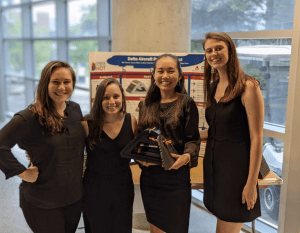Happy Throwback Thursday! This week we interviewed Jasmine Hornbeck of Chock It Like It’s Hot. The team set out to create a new chocking system with imbedded sensor network that aims to reduce compliance issues that Delta Airlines is currently facing.


Q: Could you give us a brief description of your project for those who may not know about it?
A: Aircrafts are often left without their wheels chocked or they’re simply improperly set which results in the pilots having to engage their parking brakes more than they need to — resulting in these unnecessary maintenance costs. Not only does this project allow for the opportunity to save Delta Airlines money but improperly set chocks are quite dangerous, as this can put aircrafts, facilities, equipment, and potentially people in harm’s way. The objective of this project is to reduce existing compliance issues involving the chocking of Delta’s aircrafts and we accomplished this by integrating force sensors in existing chocks that would activate when the plane has been chocked and then notify essential personnel.
Q: Where did you first draw inspiration for the idea of the “7-Aircraft Parking,” for your Capstone Design Project?
A: We knew we wanted to work with Delta, and this was the idea that interested us most as a team. It was summer capstone, so the options were a little more limited.
Q: What was the design process like and how did you and your teammates come together to finish your project?
A: To meet the design goals, our team came up with several concepts that encompassed various geometries and implementations. These concepts fell under three categories — modification of the original chock design, an entirely new chock design, and modification of airports. Modifying the airport, although novel, was definitely not feasible for a capstone project. Since we were trying to finish it in a summer, the amount of testing that would go into an entirely new chock design was also not ideal. We decided it was smartest to take advantage of what worked about the existing design and adapt it to fit the new needs identified by Delta.
Q: What were some of the problems that you faced along the way and how did you overcome those obstacles?
A: Meeting the design constraints proved very difficult as we were trying to make a new chock that could withstand the forces exerted by Delta’s planes and also integrate a sensitive sensor network. This also made meeting the weight requirement very difficult because we needed all of these new electronic components which increased the weight of the chock and sensitivity to forces yet we couldn’t remove material without compromising the structural integrity.
Q: How did it feel to work with Delta Airlines and how did they help you with the creation of your project?
A: It was pretty awesome – we met with our sponsors weekly to update them on our progress, and they would give us their insight such that we could troubleshoot any potential problems before proceeding. They gave us a tour of their facilities and we were able to test our prototype on real Delta planes so all in all, it was a fantastic experience.
Q: What do you think made your team successful in creating your project?
A:
- Effective communication, within our team and also in presenting our idea to others.
- Anticipating problems in designs before implementing them
- Creating sub-teams and identifying each team member’s strengths early on
- Having similar goals of how we wanted to perform in the class – if some teammates want to win and some simply want to pass, there will be discrepancies in the quality of deliverables.
Q: Do you have any advice for future teams?
A: Don’t over-engineer something and be realistic about your timeline. The simple solution is often best so it’s important to find a compromise early on about finding that feasible, implementable solution for industry but also being excited about your design.
Thank you Jasmine for sharing your project with us!


